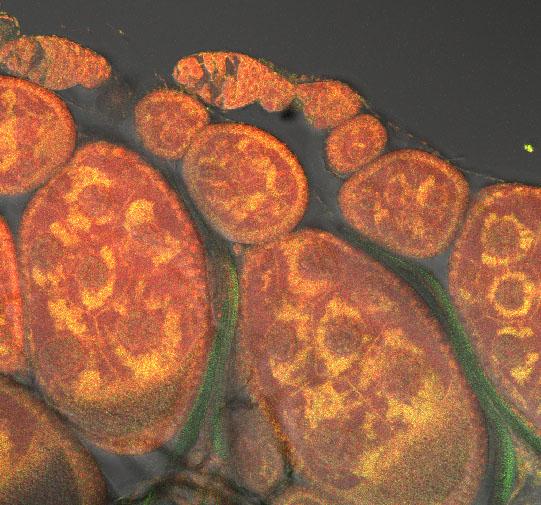PROVIDENCE, R.I. [Brown University] — Diseases from a mutation in one genome are complicated enough, but some illnesses arise from errant interactions between two genomes: the DNA in the nucleus and in the mitochondria. Scientists want to know more about how such genomic disconnects cause disease. In a step in that direction, scientists at Brown University and Indiana University have traced one such incompatibility in fruit flies down to the level of individual nucleotide mutations and describe how the genetic double whammy makes the flies sick.
“This has relevance to human disease but it’s also relevant to all organisms because these two genomes are in all animals and all plants,” said David Rand professor of biology at Brown and senior author of the study in PLoS Genetics. “There are a lot of metabolic diseases that are mitochondrial in origin and they have peculiar genetic tracking — a two-part system needs to be considered.”
Five years ago at Brown, Rand and two postdoctoral researchers — Colin Meiklejohn, of Brown and Indiana University, and Kristi Montooth, now an assistant professor at Indiana University — began searching for an example in the convenient testbed of fruit flies. They started mixing and matching mitochondrial and nuclear genomes from different strains and species of flies that carried natural mutations produced during evolution to observe what conflicts might arise. They found that when they placed the “simw 501” mitochondrial DNA from Drosophila simulans flies into Drosophila melanogaster flies with “Oregon R” nuclear DNA, bad things happened.
The flies with this combination lived but had an array of problems. Their most noticeable flaw was that whisker-like bristles on their backs were only half the length of those in normal flies. The flies also had developmental delays, reproduced less effectively, and tired more quickly, which makes sense because the mitochondria is the cell’s power plant.
Once the team, including lead author Meiklejohn, had a bona fide mitochondrial-nuclear incompatibility to study, they could then begin looking for exactly where the problem lay and how it was causing disease. In the paper, they describe the genetic and biochemical experiments they conducted to find out.
Brown graduate student Marissa Holmbeck, the paper’s second author, measured the productivity of several enzymes in the mitochondria’s power generation process. Two enzymes that are derived entirely from nuclear genes ran just as well in the sick flies as in healthy ones, but three enzymes that are jointly managed by mitochondrial and nuclear genes lagged behind in activity.
“The different complexes that are jointly encoded by the mitochondrial and nuclear subunits, those are the ones where we are seeing the defect in activity,” Holmbeck said.
Each mutation alone, in fact, does little or no harm to flies. It is only when both are present that the flies fall ill.
Meanwhile, Meiklejohn and Montooth tracked those mutations to just two altered nucleotide letters — one in each genome. In the mitochondrial genome, a G to U mutation in an RNA suggested a problem with protein production inside the mitochondria. This was confirmed when they discovered an A to V mutation in the nuclear protein that adds an amino acid to this same mitochondrial RNA.
The biochemical and genetic evidence pointed to flaws in how fast the mitochondria of the sick flies could produce proteins needed to promote growth.
“The specifics of this paper are tracking that down to the individual nucleotide,” Rand said, “But the more general lesson is that this coevolution of mitochondrial and nuclear genes has been going on for millions of years in millions of organisms and is going on in human populations today.”
In human beings, a well-known mitochondrial disease, for example, is an aversion to exercise that is due to a mutation in the same mitochondrial RNA gene the team studied in fruit flies.
Rand and his group are now conducting new experiments to trace more mito-nuclear incompatibilities within a single species to their genetic and biochemical roots.
“This paper provided proof of principle that we can identify these things and map them to their nucleotides,” Rand said. “We want to ask how common is this and can we find other sources of this kind of breakdown in mito-nuclear crosstalk underlying disease.”
In addition to Rand, Montooth, Meiklejohn, and Holmbeck, other authors on the paper are Dawn Abt of Brown and Mohammad Siddiq of Indiana.
The National Institutes of Health funded the research with several grants, including GM072399, F31AG040925, R01GM067862, R01AG027849, and GM076812. The National Science Foundation funded the research with grant DEB-0839348. Support also came from Indiana University.

